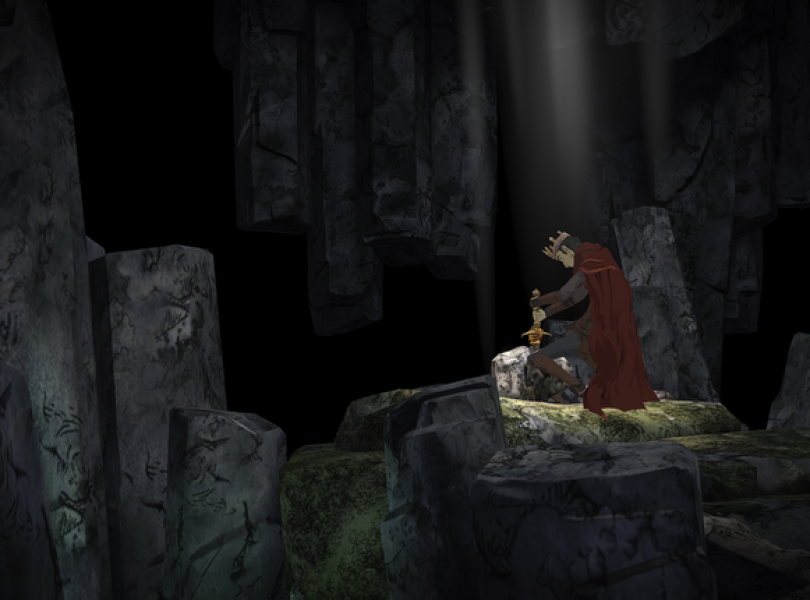Shorter and not so sweet, the second episode is a step down.
By Leif Johnson
The great first episode of the King’s Quest reboot is called “A Knight to Remember,” but that came out a little under half a year ago. Truth is, by the time the new episode, “Rubble Without a Cause” arrived in December, it’d been so long that I’d kinda sorta forgotten about it. Still, it took mere seconds for me to start smiling again at the series’ details: the oh-so-realistic flutter of protagonist Graham’s cape, say, or the slap-worthy puns Christopher Lloyd chortles out when I die or make a mistake. Much of the previous episode’s Don Bluth-meets-The Princess Bride allure still manages to shine in this otherwise dark and gloomy chapter, but overall Rubble Without a Cause does little to justify the time we’ve spent waiting for it.
We want to hear it.
The action unfolds almost entirely in a sunless cavern over a mere three hours.
The setting’s mostly to blame for that. The first episode led us into dragon lairs, cozy villages, and autumn-painted forests where we dueled knights and swapped quips with a blacksmith with a knack for gadgetry. The personalities rivaled the scenery in diversity, and its running time of five or six hours was just long enough to make it feel like a full-fledged adventure game (with a sprinkling of roleplaying) on its own.
The second episode’s locations feel underwhelming by comparison: aside from a few goofy scenes in the throne room and some interludes with Old Graham and his grandkids, the action unfolds almost entirely in a sunless cavern over a mere three hours. Graham doesn’t really meet any new people worth remembering, either, aside from a horde of goblins who speak silly gibberish and prance about with helmets that hide their expressions. Instead, he spends most of his time trying to save the folks he already knows from either starving or slipping away on account of a lack of food or medicine.
Bleak, right? It gets darker. Graham finds himself in a situation where he’s forced to choose every day between feeding himself, his friends, or a monster who might turn on him if it gets hungry, and while the predicament adds a degree of tension many adventure games don’t have, I struggle to call it fun.
It’s rough, because you also have to spend this time solving puzzles and riddles to get the other supplies your friends need, along with a means of escape for at least some of the bunch. Puzzles largely take the place of the first episode’s focus on exploration here, and they tend to present the right degree of challenge and variety, considering the circumstances. Even better, they’re packed with near-constant references to familiar tales like The Princess and the Pea, and the knowledge of them helps nicely with some of the solutions.

Episode 2: Rubble Without a Cause

Episode 2: Rubble Without a Cause
Episode 2: Rubble Without a Cause
Episode 2: Rubble Without a Cause
Episode 2: Rubble Without a Cause
Advertisement
Episode 2: Rubble Without a Cause
Episode 2: Rubble Without a Cause
Episode 2: Rubble Without a Cause
Episode 2: Rubble Without a Cause
Episode 2: Rubble Without a Cause
Advertisement
King’s Quest — Episode 2 Screen
King’s Quest — Episode 2 Screen
King’s Quest — Episode 2 Screen
King’s Quest — Episode 2 Screen
King’s Quest — Episode 2 Screen
Advertisement
King’s Quest — Episode 2 Screen
King’s Quest — Episode 2 Screen
King’s Quest — Episode 2 Screen
It’s a harrowing commentary on the life-or-death pressures of kingship.
Slip up, though, and your whole group suffers, and you’re forced to retread the same steps the next day. Dawdle too long, and you’ll almost certainly see some of your starving buds carted off to their fates because the objectives aren’t too clear and the auto-save feature doesn’t forgive errors in your trials. It’s a harrowing commentary on the life-or-death pressures of kingship (nicely counterpointed by more mundane tasks in the opening minutes), and the reuse of the first episode’s strong cast means there’s much emotional attachment on the line. It’s often maddening, but the stakes involved nicely encourage real thought over slapdash experimentation. On the bright side, Rubble Without a Cause introduces the ability to skip over cutscenes you’ve already seen, which takes some of the bite out of the inevitable repetition in the puzzles and daily backtracking.
The ending wraps things up nicely while finally finding the story’s footing, though, and naturally sets events up for the next episode. Hopefully, whenever it comes, it’ll be more robust. Rubble isn’t without its strengths; the writing still enchants when it actually shows up. Moments of beauty skulk in the many shadows, such as the bird’s-eye shots of Graham ascending the goblins’ subterranean stairwell with his flowing cape, and in the little details I still admire, such as the way Graham’s arms hang limply when he’s sapped of strength. Yet it certainly suffers from a bad case of “Middle Episode Syndrome.” The symptoms pop up almost everywhere, whether it’s in the comparatively humdrum scenes with Old Graham and his granddaughter or in some of the rushed and (in one case) seemingly unfinished cinematic transitions in the caves.
Take it from Graham himself, who might be repping developer The Odd Gentlemen toward the end. “How ’bout a new story?” he asks tremulously. How about it indeed.
Shorter and far less focused on exploration than its preceding episode, King’s Quest: Rubble Without a Cause still usually manages to deliver smaller doses of the art style and writing that made the series premiere so appealing. There are plenty of fun puzzles in store along with a timer mechanic, but the cramped, dark setting and lack of visual variety tends to rob these elements of the charm they could have.



